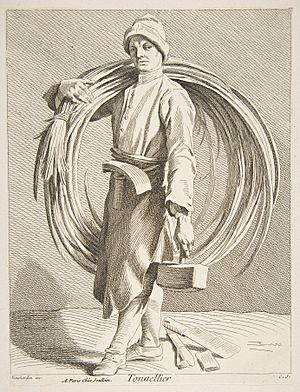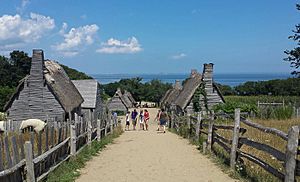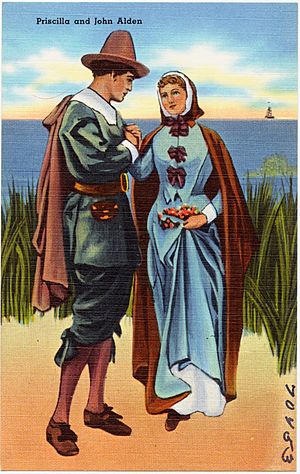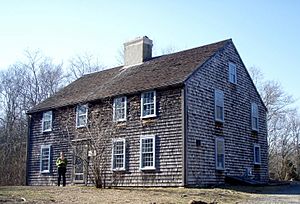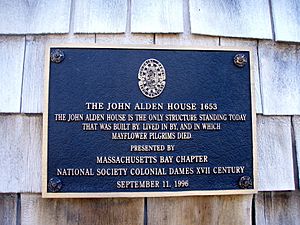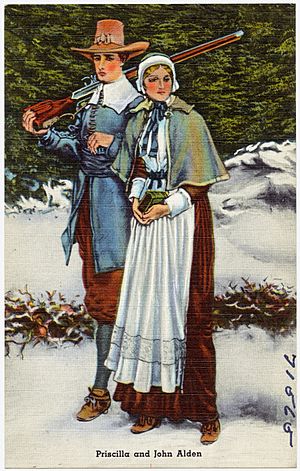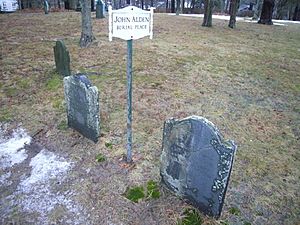John Alden facts for kids
Quick facts for kids
John Alden
|
|
|---|---|
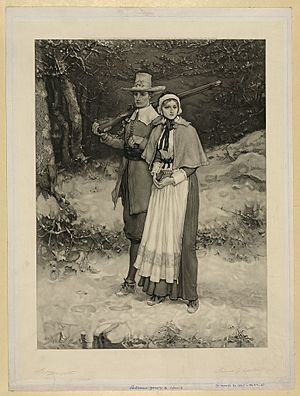
A conjectural image of John and Priscilla Alden by George Henry Boughton, 1884
|
|
| Assistant Governor of Plymouth Colony | |
| Personal details | |
| Born | c. 1598 England |
| Died | September 12, 1687 (aged 89) Plymouth Colony, America |
| Spouse | Priscilla Mullins |
| Children | 10 |
| Occupation | Assistant Governor, Deputy Governor, Fur Trader, Cooper |
| Signature | |
John Alden (born around 1598 – died September 12, 1687) was an important person in the early days of Plymouth Colony. He was a crew member on the famous 1620 voyage of the Mayflower. This ship brought English settlers, known as Pilgrims, to what is now Massachusetts, USA.
John Alden was hired in Southampton, England, to be the ship's cooper. A cooper is someone who makes and repairs wooden barrels. Even though he was part of the ship's crew and not a settler, Alden decided to stay in Plymouth Colony. He did not return to England with the Mayflower. He was one of the people who signed the Mayflower Compact, an important agreement for the new colony.
He later married Priscilla Mullins, who was also a passenger on the Mayflower. Priscilla's whole family died during the first difficult winter in Plymouth Colony. Their marriage became famous in the 1800s. This was after Henry Wadsworth Longfellow wrote a poem called The Courtship of Miles Standish in 1858. This poem led to many pictures and stories about John and Priscilla Alden.
Alden was a very active public servant in Plymouth Colony. He was elected to the Governor's Council almost every year from 1640 to 1686. He also served as Treasurer, Deputy to the General Court, and a member of the colony's Council of War. He was the last person alive who had signed the Mayflower Compact when he died in 1687. Today, you can visit the place where his first house stood in Duxbury. The Alden Kindred of America, a group of his descendants, looks after the Alden House Historic Site.
Contents
John Alden's Early Life in England
Historians have different ideas about where John Alden came from in England. What we know for sure comes from William Bradford's book, Of Plymouth Plantation. Bradford was the Governor of Plymouth Colony. He wrote that Alden "was hired for a cooper, at Southampton, where the ship victuled." This means Alden was hired in Southampton, where the Mayflower got its supplies.
Bradford also wrote that Alden was a "hopefull yong man." He was allowed to choose if he wanted to stay in America or go back to England. John Alden chose to stay. Some historians think he might have been from Harwich, a port town in England. This was also the home port of the Mayflower and its captain, Christopher Jones. It's possible Alden knew Captain Jones before the voyage.
Another idea is that John Alden might have been from Southampton. A tax list from 1602 in Southampton shows the names of George Alden and William Mullins. William Mullins was Priscilla's father. If their families were both from Southampton, maybe John and Priscilla knew each other before the voyage.
The Mayflower Journey
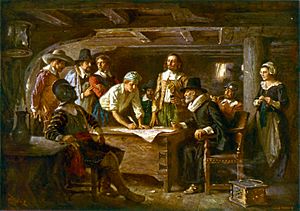
John Alden was about 21 years old when Captain Christopher Jones hired him. His job was to be the ship's cooper during the Mayflower's trip to America. Because he was skilled at making and fixing barrels, the colonists wanted him to stay with them in America.
The Mayflower left Plymouth, England, on September 6, 1620. The ship was about 100 feet long. It carried 102 passengers and about 20 to 30 crew members. Conditions were very crowded. Many people got sick because of poor food and dirty conditions. Sadly, many died, especially women and children.
After about two months at sea, they saw Cape Cod on November 9, 1620. Their first plan was to go to the Hudson River area. But Captain Jones found the currents and shallow waters too dangerous. Because many passengers were sick and supplies were low, they decided to settle in New England instead. The Mayflower finally dropped anchor on November 11 in Provincetown Harbor.
Settling outside the original plan caused a problem. Their official document, called a land patent, was only for the Virginia Colony. This meant some people questioned who was in charge. To fix this, the leaders created the Mayflower Compact. This was an agreement to work together and obey the laws they would make. All the free male settlers signed it on November 11. John Alden signed it, which showed he had already decided to stay. He was the youngest person to sign and the last one to die.
Building Plymouth Colony
After exploring the coast, the colonists chose to settle in Plymouth. It had a good harbor, fresh water, and a hill for a fort. The Patuxet tribe had lived there and cleared land for planting corn. However, by the time the Mayflower arrived, the Patuxet tribe had been wiped out by diseases. These diseases likely came from contact with English fishermen.
During their first winter, many settlers got sick. Half of them died. Priscilla Mullins, who would become John Alden's wife, lost her entire family. The 50 people who survived started building a fort and small wooden houses. These houses were on a "street" now called Leyden Street. John Alden built a simple house on a small plot of land there. He lived there for about seven years with Priscilla and their growing family. Today, a recreation of this house stands at Plimoth Plantation, a living history museum that shows what the Pilgrim settlement looked like.
John and Priscilla Alden's Marriage
We don't know the exact date John Alden married Priscilla Mullins. It was probably in 1622. This was either the second or third marriage in the new colony.
Their marriage became very famous because of Henry Wadsworth Longfellow's poem, The Courtship of Miles Standish. This poem was published in 1858. The story is fictional and tells about a love triangle between John Alden, Priscilla Mullins, and Myles Standish. Standish was the captain of the colony's militia. In the poem, Standish is too shy to tell Priscilla how he feels. So, he asks John Alden to speak for him. Priscilla then famously asks, "Why don't you speak for yourself, John?"
The book was incredibly popular. It sold 10,000 copies in London in one day. In the United States, it made the Pilgrims well-known. It even helped establish the national Thanksgiving holiday in 1863. The poem made John and Priscilla Alden celebrated figures in American culture.
Some historians say the story is "loosely based" on Alden family stories passed down. Others say it's completely made up. There is no proof from the 1600s to support the story.
John Alden's Public Service
In 1626, the people who had funded the colony in London, called the Merchant Adventurers, stopped their support. This meant the colonists had a lot of debt. Eight of the Plymouth colonists, including John Alden, agreed to take on this debt themselves. In return, they got a special right to control the fur trade for the colony. These men were called the "Undertakers." John Alden being one of them shows how important he was becoming in the colony.
Alden was elected as the Governor's Assistant in 1632. This meant he was one of a small group of advisors to the Governor. He was reelected almost every year until 1686. He also served as Deputy Governor twice when the Governor was away. From 1656 to 1658, he was elected Treasurer every year.
John Alden was also on the colony's Council of War several times. This committee made important decisions about defending the colony. The Plymouth General Court also put Alden on many other important committees. These included the Committee to Revise Laws and the Committee on the Kennebec Trade. He later served as a magistrate, which is like a judge.
Plymouth Colony had the right to control the fur trade on the Kennebec River in what is now Maine. In 1634, a man named John Hocking caused trouble there. He shot a Plymouth colonist, and then a Plymouth man shot Hocking. When the Plymouth traders arrived in Boston, authorities there arrested John Alden. He was on the ship, but he wasn't there when the shooting happened. He was only released after William Bradford helped him.
Settling in Duxbury
In January 1628, land around Plymouth Bay was divided into farm lots. Each person got 20 acres, plus 20 more for each family member. John and Priscilla Alden had three children then, so they received 100 acres. This land was along the Bluefish River in an area called Duxbury.
The location of their farm was chosen by chance, but it was perfect. It had land partly cleared by Native Americans, woods, and salt marshes for hay. Alden built their first small house there in 1628. For the first few years, they lived on their Duxbury farm seasonally. They had to travel 10 miles to Plymouth every Sunday for church. So, they stayed in Plymouth during the winter to avoid long trips in bad weather.
Today, you can still see the outline of their first house. It's marked by a boulder and signs. A halberd blade, a type of weapon, was found there during an archaeological dig in 1960. It is now at the Pilgrim Hall Museum.
In 1632, John Alden and others asked the colony to have Duxbury become a separate church area. This would let people live on their farms all year. The colony leaders agreed, and Duxbury became its own town in 1637. John Alden became a leader in Duxbury and an important person in the colony. He served as Deputy from Duxbury to the General Court for most of the 1640s.
For a long time, people thought another Alden house in Duxbury was John and Priscilla's second home, built in 1653. This house is now a museum called the Alden House Historic Site. However, studies in 2003 showed that this house was likely built around 1700. This means it was probably built by one of their children, like Jonathan Alden, or even a grandchild. Both the site of their first Duxbury home and the Alden House Historic Site were named a National Historic Landmark in 2008.
John and Priscilla Alden's Family
John and Priscilla Alden had ten children:
- Elizabeth was born in 1623 in Plymouth. She died in 1717. She married William Pabodie and had 13 children.
- John Jr. was born around 1626 in Plymouth. He died in Boston in 1701/2. He married Elizabeth (Phillips) Everill and had 14 children. He became a successful merchant. In 1692, he was accused of being a witch during the Salem witch trials. He was jailed but escaped to Duxbury.
- Joseph was born around 1628. He died in 1696/7. He married Mary Simmons and had seven children.
- Priscilla was born around 1630. We know little about her, but she was alive and unmarried in 1688.
- Jonathan was born around 1632. He died in Duxbury in 1697. He married Abigail Hallett and had six children. Jonathan was a captain in the Plymouth Colony militia.
- Sarah was born around 1634. She died before 1688. She married Alexander Standish, who was Myles Standish's son. They had eight children.
- Ruth was born around 1636. She died in 1674. She married John Bass and had seven children. One of her children, Hannah Bass, was the grandmother of future United States President John Adams.
- Mary was born around 1638. She was alive and unmarried in 1688.
- Rebecca was born around 1640. She married Thomas Delano in 1677 and had nine children. She died between 1696 and 1722.
- David was born around 1642. He died in Duxbury between 1718 and 1719. He married Mary Southworth and had six children.
John Alden's Later Life and Legacy
John Alden was the last person alive who had signed the Mayflower Compact. He died in Duxbury on September 12, 1687. Both he and his wife Priscilla were buried in the Old Burying Ground in South Duxbury. We don't know the exact spot of their graves because markers either weren't placed or have worn away. In 1930, the Alden Kindred of America placed special memorial stones near where they think John and Priscilla were buried. These stones are close to the headstone of their son, Captain Jonathan Alden.
You can see several items that belonged to John Alden in museums. These include the halberd blade found at his first house site in Duxbury. The Alden family bible and a mortar and pestle (tools for grinding) are also on display at the Pilgrim Hall Museum. A special type of gun, called a wheel-lock carbine, which belonged to John Alden, is at the National Firearms Museum. This gun was found in the Alden House during a restoration in 1924.
The Alden Kindred of America was started in 1906. At first, it was only for people who were descendants of John Alden. Now, it's a non-profit group that welcomes both descendants and non-descendants. This organization manages the Alden House Historic Site in Duxbury, Massachusetts.
See also
 In Spanish: John Alden para niños
In Spanish: John Alden para niños


